|
|
|
Sort Order |
|
|
|
Items / Page
|
|
|
|
|
|
|
| Srl | Item |
| 1 |
ID:
131763


|
|
|
|
|
| Publication |
2014.
|
| Summary/Abstract |
This article argues that the Aden Insurgency was a pivotal moment in the history of British counter-insurgency. We argue that it was in Aden where the newfound strength of human rights discourse, embodied in Amnesty International, and of anti-colonial sentiment, expressed by the UN General Assembly, forced the British government to pay attention to public perceptions of colonial brutality. Using archival sources, we foreground three episodes in the history of the insurgency to support our argument and to illustrate that the changes witnessed were not the result of 'learning' but of a fundamental shift in the international environment.
|
|
|
|
|
|
|
|
|
|
|
|
|
|
|
|
| 2 |
ID:
131823
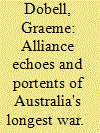

|
|
|
|
|
| Publication |
2014.
|
| Summary/Abstract |
Afghanistan was Australia's longest war, yet the consensus between Australia's major political parties on the commitment never wavered over 12 years. The bipartisan unity held even as the nature of the war changed and evolved, Australian casualties rose and popular support fell away. The enduring centrality of the US alliance explains much-probably almost all you need to know-about the unbroken consensus of the Australian polity. Afghanistan was an example of the Australian alliance addiction, similar to Vietnam. As with Vietnam, the Australian military left Afghanistan believing it won its bit of the war, even if the Afghanistan war is judged a disaster. As Australia heads home it finds the USA pivoting in its direction; with all the similarities that can be drawn between Vietnam and Afghanistan, this post-war alliance effect is a huge difference between the two conflicts.
|
|
|
|
|
|
|
|
|
|
|
|
|
|
|
|
| 3 |
ID:
121864
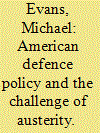

|
|
|
|
|
| Publication |
2013.
|
| Summary/Abstract |
This article examines the Obama administration's attempt to rebalance U.S. strategy towards the Asia-Pacific region with special emphasis on Southeast Asia. It argues that America's regional pivot is occurring at a time of unprecedented domestic fiscal austerity caused by a staggering level of national debt. The U.S. domestic budget crisis, the current "declinist" debate, concern over the rise of China, and the impact of sequestration on American defence spending are analysed and their implications for Southeast Asia are assessed. The article suggests that the most serious aspect of the U.S. debt crisis may be its impact upon American strategic resilience and geopolitical confidence. Thus, while many ASEAN nations have welcomed the U.S. strategic pivot as a valuable reinforcement of their security, they remain unsure that it is a sustainable policy. In the future, it is likely that reassuring ASEAN of the longevity of the U.S. commitment to the Asia-Pacific will require of Washington a skilled blend of budgetary reform, military presence, and sustained diplomatic effort.
|
|
|
|
|
|
|
|
|
|
|
|
|
|
|
|
| 4 |
ID:
138289
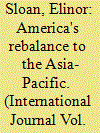

|
|
|
|
|
| Summary/Abstract |
This paper examines the impact of the US pivot to the Asia-Pacific on Canada’s strategic thinking and maritime posture. It highlights elements of the US rebalance before examining Canada’s recent past, present, and future strategic and military engagement. Canada wants to be able to contribute to crisis de-escalation if regional tensions lead to conflict, yet the Royal Canadian Navy has less deployment capacity today than it has had in 25 years. To contribute to mediatory influence, and provide warfighting capability, a recapitalized navy should increase deployments to the region, forward deploy some naval assets, and ensure interoperability with its US counterpart. In the event of a crisis, a choice might have to be made between a neutral, honest-broker stance and a more likely decision to contribute forces to a US-led coalition. The first step in either case is to be in the Asia-Pacific region with capable and credible naval forces.
|
|
|
|
|
|
|
|
|
|
|
|
|
|
|
|
| 5 |
ID:
167739
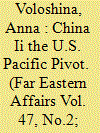

|
|
|
|
|
| Summary/Abstract |
In 2011, the U.S. Obama Administration officially put forward a geopolitical initiative that went down in history under the name of "pivot," or rebalance. A major element of that strategy, which was intended to guarantee U.S.A.'s dominant position in the Asia-Pacific Region (APR), became the building of constructive relations with China. This paper attempts to show how the Chinese vector of the pivot occurred and developed. Our analysis has yielded a conclusion about the changes that the pivot has undergone with the replacement of the U.S. administrations and also prompted a question about the efficiency of this strategy in terms of carrying out the objectives set by the United States.
|
|
|
|
|
|
|
|
|
|
|
|
|
|
|
|
| 6 |
ID:
131324
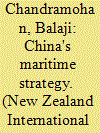

|
|
|
|
|
| Publication |
2014.
|
| Summary/Abstract |
After long being a continental power, China in the 21st century has started to follow an ambitious maritime expansion course, seeking to bolster its power-projection capabilities, especially n North Asia, South-east Asia, the South-west Pacific and the South Pacific. This has pushed the countries in the Asia-Pacific region such as Australia, India, Vietnam, Philippines and Indonesia to form an effective strategic partnership. Further, it has induced the United States to increase its maritime military presence in the region--with a view to having a forward presence or pivot. It has sought increased strategic co-operation and alliance with countries that are wary of China's expanding maritime presence.
|
|
|
|
|
|
|
|
|
|
|
|
|
|
|
|
| 7 |
ID:
132512
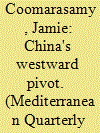

|
|
|
|
|
| Publication |
2014.
|
| Summary/Abstract |
The essay summarizes a recent reporting trip by the author to Tajikistan and Kyrgyzstan for the BBC, during which he examined the reasons for and observed the practical impact of China's growing influence in the former Soviet republics of Central Asia. The author provides a firsthand account of the scale and scope of Beijing's economic and, to a lesser extent, cultural investment in the region and of the way that local society is reacting to the changes. The essay also considers what the effects are for the traditional regional power, Russia, and looks at the Kremlin's response to the arrival of China as a major player in Central Asia.
|
|
|
|
|
|
|
|
|
|
|
|
|
|
|
|
| 8 |
ID:
130472


|
|
|
|
|
| Publication |
2014.
|
| Summary/Abstract |
The United States is in the early stages of a substantial national project: reorienting its foreign policy to commit greater attention and resources to the Asia-Pacific region. This reformulation of U.S. priorities has emerged during a period of much-needed strategic reassessment, after more than a decade of intense engagement with South Asia and the Middle East. It is premised on the idea that the history of the twenty-first century will be written largely in the Asia-Pacific, a region that welcomes U.S. leadership and rewards U.S. engagement with a positive return on political, economic, and military investments.
As a result, the Obama administration is orchestrating a comprehensive set of diplomatic, economic, and security initiatives now known as the "pivot," or "rebalancing," to Asia. The policy builds on more than a century of U.S. involvement in the region, including important steps taken by the Clinton and George W. Bush administrations; as President Barack Obama has rightly noted, the United States is in reality and rhetoric already a "Pacific power." But the rebalancing does represent a significant elevation of Asia's place in U.S. foreign policy.
Questions about the purpose and scope of the new approach emerged as soon as Secretary of State Hillary Clinton offered what remains the clearest articulation of the strategy, and first used the term "pivot" to describe it, in a 2011 article in Foreign Policy. Almost three years later, the Obama administration still confronts the persistent challenge of explaining the concept and delivering on its promise. But despite the intense scrutiny and short-term setbacks faced by the policy, there is little doubt that a major shift is well under way. And whether Washington wants it to or not, Asia will command more attention and resources from the United States, thanks to the region's growing prosperity and influence -- and the enormous challenges the region poses. The question, then, is not whether the United States will focus more on Asia but whether it can do so with the necessary resolve, resources, and wisdom.
|
|
|
|
|
|
|
|
|
|
|
|
|
|
|
|
| 9 |
ID:
130879
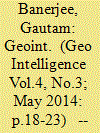

|
|
|
|
|
| Publication |
2014.
|
| Summary/Abstract |
Combat, by its very definition, is an event extra-ordinarily excruciating. It is an ultimate condition that is distinguishable by its phenomenal characteristics which demand, among other undertakings, absolute perfection in marshalling the diverse elements of combat that constitute a military force, for example, troops, firepower, mobility and intelligence. Thus down the ages, 'Great Captains' of war have articulated their strategic intellect to secure victory, irrespective of the bulk of forces, by the best orchestration of the resources under their command. In modern times, developments in 'Information Warfare' have raised the bar of such Terrain intelligence has always been important for winning a battle. In this aricle, the writer advocates establishing a repository of battle-space geographic information called Military Geospatial Intelligence System (MGIS) orchestration to such a high level that it becomes possible to exploit to the hilt the individual capabilities of each element of the military machine. More importantly, it is possible now to seamlessly integrate all such diverse force-elements into one whole system of war-fighting. Military intelligence - terrestrial, strategic and tactical - has always been the most decisive factor in application of combat power as well as an enabling tool for the aforementioned 'best' orchestration of military resources. Within its overall ambit, terrain intelligence - geospatial intelligence in the wider sense as we understand today - has been the pivot of strategic, operational and tactical decision making. In the contemporary period of technological explosion, that pivot has assumed unlimited scope for articulation. At the crosshairs of ever-adversarial forces across terrains of unique descriptions, institution of an efficient mechanism for harnessing the properties of geospatial intelligence - MGIS - must, therefore, be a top priority for India. However, to be really effective, that endeavour has to be tailored to Indian conditions and backed up with indigenous competences; the scope and coverage of GIS as propounded by the lead militaries of the world, USA, China, NATO and Russia, is neither accessible nor sustainable and may not even be necessary in the context of India's technical-industrial-fiscal capacity, and inter alia, her military objectives.
|
|
|
|
|
|
|
|
|
|
|
|
|
|
|
|
| 10 |
ID:
137579
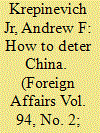

|
|
|
|
|
| Summary/Abstract |
In the U.S. military, at least, the “pivot” to Asia has begun. By 2020, the navy and the air force plan to base 60 percent of their forces in the Asia-Pacific region. The Pentagon, meanwhile, is investing a growing share of its shrinking resources in new long-range bombers and nuclear-powered submarines designed to operate in high-threat environments.
|
|
|
|
|
|
|
|
|
|
|
|
|
|
|
|
| 11 |
ID:
152899
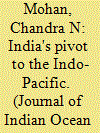

|
|
|
| 12 |
ID:
140520
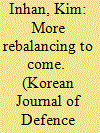

|
|
|
|
|
| Summary/Abstract |
For the past two years, the Asia-Pacific seems to have returned to the back seat in U.S. foreign policy priorities because of crises in Europe and the Middle East, and Washington’s own fiscal problems. Given both global and domestic developments, it is a legitimate question to ask whether the U.S. rebalance to the Asia-Pacific is still valid. This paper asserts, “Yes, it is.” Washington has made steady progress across military, diplomatic, and economic realms of the rebalancing. It has strengthened and expanded military ties with regional states and prepared for its naval forces to operate more intensively. It has become a member of major multilateral institutions and expanded support for appropriate organizations. And it is striving to complete the most important trade deal in a generation, the Trans-Pacific Partnership. Despite budget pressures, the Obama administration has kept the Asia-Pacific high on its foreign policy agenda, and the rebalance has enjoyed bipartisan support. While the high-profile rebalancing moves have been relatively modest so far, the Obama administration’s achievements should not be understated. More balancing effort is certain to come.
|
|
|
|
|
|
|
|
|
|
|
|
|
|
|
|
| 13 |
ID:
145229
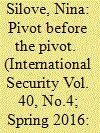

|
|
|
|
|
| Summary/Abstract |
American critics of the Barack Obama administration's 2011 “pivot to Asia” policy claim that, despite the lofty rhetoric, the United States has pursued an anemic strategy in Asia. Chinese critics of the pivot to Asia assert that it is a bellicose strategy aimed at containing China's rise. These two conflicting criticisms are addressed in a detailed historical narrative that traces the development and implementation of U.S. strategy, based on declassified documents, some of which have never before been made public, and extensive in-depth interviews with senior policymakers. Neither American nor Chinese critics of the pivot to Asia are correct. If this policy is properly dated and measured, the United States undertook a substantive military, diplomatic, and later economic reorientation toward Asia. That reorientation started in the mid-2000s, well before the pivot announcement. The aim of the reorientation was not to contain China's rise. Rather, the United States sought to manage China's growth through a blend of internal and external balancing combined with expanded engagement with China. These means were intended to work symbiotically to expand the combined power of the United States and its allies and partners in Asia, and to dissuade China from bidding for hegemony. The ultimate effect of the reorientation strategy—if successful—would be to preserve the existing power balance in the region, in which the United States has held the superior position.
|
|
|
|
|
|
|
|
|
|
|
|
|
|
|
|
| 14 |
ID:
132556


|
|
|
|
|
| Publication |
2014.
|
| Summary/Abstract |
The article examines the reorientation of the defense policy of the United States, initiated during the Bush and Obama Administrations, toward giving increased priority to the Asia Pacific region. It begins with the historical perspective of the development of American naval power in the twentieth century. The world wars, in which Europe represented the primary theater of conflict, had the effect of shifting a greater share of American military assets toward the Euro-Atlantic theatre, while the onset of the Cold War after 1945 required the United States to develop a navy of truly global strategic reach in which Atlantic and Pacific commitments were kept in balance. With the diminished concern for European security since the end of the Cold War and the emergence of the People's Republic of China as a Strategic Competitor in the Asia Pacific region, the United States is required in an age of defense austerity to refocus attention again to the Pacific.
|
|
|
|
|
|
|
|
|
|
|
|
|
|
|
|
| 15 |
ID:
125642
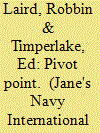

|
|
|
|
|
| Publication |
2013.
|
| Summary/Abstract |
The strategic pivot toward the Asia-Pacific region is intended to rebalance the projection and focus of US military power in the years ahead. However, it will not be without its challenges.
|
|
|
|
|
|
|
|
|
|
|
|
|
|
|
|
| 16 |
ID:
137213
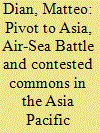

|
|
|
|
|
| Summary/Abstract |
The Pivot towards the Asia Pacific has been a key component of the grand strategy of the Obama administration. Militarily, the main challenge is represented by the Chinese capacity to erode the American ‘command of the commons’.
The United States have been developing a new operational concept, labelled ‘Air-Sea Battle’ (ASB) aimed at maintaining the capacity to project military power even if adversaries are able to deploy a sophisticated anti-access area denial strategy.
The implementation of ASB is likely induce Beijing to respond with a further acceleration of the process ofmodernisation of its armed forces.
|
|
|
|
|
|
|
|
|
|
|
|
|
|
|
|
| 17 |
ID:
131358
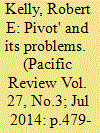

|
|
|
|
|
| Publication |
2014.
|
| Summary/Abstract |
This paper posits four ranked, generic goals of state foreign policy, maps them against the American 'pivot,' and concludes with possible handicaps of that shift. Drawn broadly from realism and liberalism, those abstract goals are as follows: national security, economic growth, prestige among the community of states, and the promotion of cherished national values. Applying this framework specifically to Northeast Asia, the USA, regarding security, is likely to increasingly 'hedge' China, and its North Korean client, with regional allies, off-shore balancing, and a shift toward AirSea Battle. On trade, the USA will continue its decades-long effort to reduce Asian mercantilism by tying Asian traders into multilateral, neoliberal rule sets. Regarding prestige, the 'Beijing Consensus' is a growing challenge to US soft power which the pivot seeks to refute. In addition, on values, the USA will continue to nag especially China to conform to US standards of law and human rights. The USA will continue to push the broad liberalization of Asian polities and economies. The democratic peace and liberal trade are the ideological frame and motivation of the pivot. Nevertheless, significant US handicaps may slow the pivot: American cultural distance from Asia means little public support and understanding of its necessity; strong regional allies will tempt the USA toward offshore balancing on the cheap; and the dire US budget shortfall will reduce the resources necessary to fund it.
|
|
|
|
|
|
|
|
|
|
|
|
|
|
|
|
| 18 |
ID:
131030
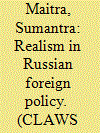

|
|
|
|
|
| Publication |
2014.
|
| Summary/Abstract |
The Crimean crisis marks a pivotal point in the rations between Russia and the West. The revolution in Ukraine, and the subsequent events that unfolded at breakneck pace, including the annexation of Crimea by Russia, throws up a lot of questions, the answers to which will have a massive impact on foreign policy and inter-state relations in the future. It also throws up some broad patterns. The crisis is a worrying return to a trend of land annexation by a great power on a pretext, a trend which was thought to be long dead Munich Conference of 2007. It brings back the debate on the concepts of "Perception and Resolve" in foreign policy. And, perhaps, most importantly, it serves as a vindication of realists over the liberals, constructivists and other paradigms of international relations, and validates the often discussed idea that state interests triumph over every other aspect.
|
|
|
|
|
|
|
|
|
|
|
|
|
|
|
|
| 19 |
ID:
124101
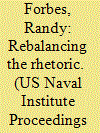

|
|
|
|
|
| Publication |
2012.
|
| Summary/Abstract |
The 'pivot' toward the Asia-Pacific region is a lofty objective, but maritime assets available to execute it-existing and planned-are simply not enough.
|
|
|
|
|
|
|
|
|
|
|
|
|
|
|
|
| 20 |
ID:
130194
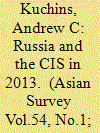

|
|
|
|
|
| Publication |
2014.
|
| Summary/Abstract |
As global demand for energy supplies grew, Russia's Far East and Eastern Siberia in 2013 acquired ever more importance in the region's geopolitics. Moscow and Beijing reached accord on joint development of key oil fields in Eastern Siberia. But Moscow used arms sales to Vietnam as part of an apparent effort to thwart Chinese hegemony in the South China Sea. Still, just as Russian comparative economic advantage with Europe and the West has derived primarily from oil and gas, so has integration with Asia hinged on energy.
|
|
|
|
|
|
|
|
|
|
|
|
|
|
|
|
|
|
|
|
|